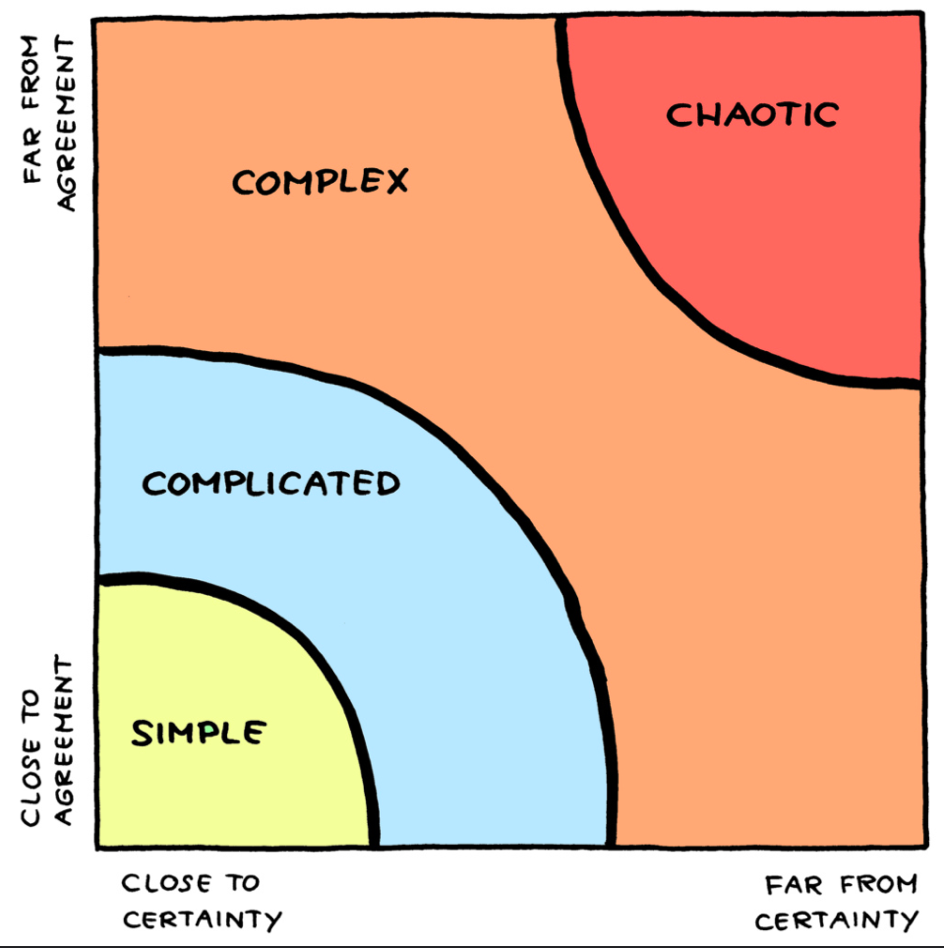Everyone is talking about agile companies. But what exactly is agile? And: What does “agile” mean in the context of a company? I would like to try to give a first definition. I would like to emphasize that I limit myself to the definition of agility for companies. Many companies see agility as a kind of holy grail, which can solve all problems and mix the term with various things. We often hear the sentence: “We are now doing it agile!”

What is agile Agile companies
In this article I will give a brief introduction as well as a quick definition. Then I’ll go into the measurability and dimensions of agility.
In order to define agility precisely, I first looked at numerous books and assigned various properties to agility. Then I provide a second definition from the typical practice books about Laloux, Gloger and Co.
Tip: I have already published this definition in an academic publication so that it can easily be cited for further use. (Lindner et al. 2017)
A quick definition
If you only want a rough definition in one sentence, then I recommend my personally favorite definition. Agility is (Lindner and Leyh 2018 and Termer 2016):
… the ability of the information function of a company to make preparations in order to react very quickly to changing capacity requirements and changed functional requirements, if possible in real time, and to be able to use the possibilities of information technology in such a way that the technical scope of the company is expanded or even can be redesigned.
Agility as an ability, skill and behavior
Be it in practical literature or in the academy: Agility is always described as a behavior, ability or skill as well as a mindset. But what does that mean? My colleague Termer (2016) already outlined the differences:
ability : Agility is understood as an organism’s existing potential to be able to do something. However, the potential does not have to be used.
skill : Agility describes the actual ability and the actual application of abilities of an organism that is evoked by an activating component.
behavior : Agility represents an organism’s own contribution in the form of actions that are directed towards the environment. Agility becomes visible through actions.
Tip: Take a look at Termer’s book .
Excursus: Can I measure agility?
Managers and students often try to measure agility in the company when doing their theses. This is only possible to a limited extent and depends on the perspective.
We see Agility as a skill then an evaluation is not possible. Agility is either there or not. It is just being used. Examples of skills are comprehension and assertiveness. You will find that you either have it or you don’t. However, it can only be measured with the help of gut instinct and can hardly be influenced.
We see Agility, however, as a skill It is possible to measure it on the basis of objective comparison criteria, since skills are task-related (Termer 2016). It’s like cycling, swimming or sprinting. You can rate the elegance or measure the time taken for a route. Agility can be trained and is also used based on one’s own motivation. Agility can also be learned from this perspective.
Agility as behavior is possible in terms of target achievement. Examples are speaking, listening, being kind, and aggression. Agility is triggered by stimuli. It should use certain emotions to steer a situation in one direction (goal). For example, you want to intimidate the other person by yelling at them and convince them of your opinion. So you can measure agility based on target achievement.
Definition from the academy
Agility is not clearly defined in the context of companies. There is a new definition in almost every paper. For this reason, I looked for the most cited publications and examined aspects that connect them to agility. A total of 7 aspects could be found, which were named unanimously in all 10 publications.
- speed
- Adaptation
- flexibility
- dynamics
- Networking
- trust
- self-organisation
The property speed is mentioned in all 10 publications in connection with agility. For example, Lu and Ramanurthy (2011) assign agility a quick reaction to change, as well as a quick implementation of products or services that can be changed quickly.
Another characteristic of agility is flexibility. Nissen and Rennenkampf (2013) describe agility with a so-called Staff flexibility in the sense of well-trained and versatile IT employees who favor the reaction to unforeseen changes. Sambamurthy et al. (2003) also see the implementation of changeable and flexible solutions as a characteristic of agility.
According to Termer (2016), agility is the ability to adapt to changing framework conditions and new market situations. According to Nissen and Rennenkampf (2013), the continuous improvement and flexibility that agility offers is the basis for this pronounced adaptability.
Furthermore, dynamics are mentioned in the context of agility. “Agility represents the use of a certain form of mobility” (Termer and Nissen 2015). According to Termer and Nissen (2015), movement in the context of agility means that a person’s position in relation to their environment changes over time. Agility means creating this flexibility out of your own drive, usually even before a situation or event makes this flexibility necessary or necessary, according to Termer and Nissen (2015).
Agility requires strong communication in a network of individuals (Appelo 2010). For this reason, Appelo (2010) also ascribes a high degree of networking to agility, since properties such as flexibility and trust are based on the relationship and communication between individuals.
Conversely, networking is also based on trust. Termer (2016) justifies this from the fact that flat hierarchies and autonomous working groups with short decision-making paths must be established through the promotion of creativity and a culture based on trust.
Self-organization also plays a role in the context of agility. According to Gloger and Rößner (2015), self-organization is a controlled and intensive learning process. Self-organization in the context of agility is also complex, people-oriented and an autonomously controlled and intensive learning process.
Definition from practice books
What is agile According to the dictionary, agile means: agile, lively and agile. According to Gloger and Margetich (2014, p. 5), agility is an attitude, i.e. a behavior and is based on the agile manifesto:
- Individuals and interactions instead of processes and tools
- functioning software instead of comprehensive documentation
- more cooperation with the customer instead of contract negotiations
- Responding to change instead of just following a plan
In the course of the blog, I relate agility to the entire organization and orient myself to the principles of agility according to Brandes (2015, p. 6):
- Deliver what is needed
- Really understand customers
- Invigorate organizations together
- Honestly inspire people
- New perspectives open up new perspectives
… as well as the principles of agile management (Appelo 2010, p. 11):
- self-organisation
- simplicity
- Team decisions
- transparency
In summary, agility is a mixture of principles and therefore behavior (Gloger & Rösner, p. 87).
Reading tip: Take a look at that too Book of Brandes and Appelo .
Further definition
Roberston (2015, p. 4ff) defines an agile organization as “a developing organization” – that is, as a company that changes with current circumstances.
Laloux (2015, p. 43f) defines an agile organization as an evolution of consciousness towards complex, refined behaviors and forms of relationships. These organizations are subject to constant change in that they build on strengths, deal with adversity, show wisdom beyond rationality and strive for wholeness – i.e. have a corresponding foresight and willingness to change (Laloux 2015, p. 51). In summary, Laloux (2015, p. 53) describes these as self-guiding and changing systems.
Reading tip: Take a look at this Book of Laloux or in that Book by Robertson .
And when should I be agile?
The Stacey Matrix below shows when agile methods should be used. For simple tasks such as routine tasks or recurring tasks, agile methods often do not make sense. Complicated things are understandable problems and the requirements are often quite clear at this point. It becomes chaotic or complex as soon as requirements and / or methodology become increasingly nebulous and you have to reckon with many unknowns. Then comes the time of agile methods.

Conclusion: agile companies!
It should be noted that the definition is not yet clear and we therefore do not yet have a clear answer to the question: “What is agile?” can deliver. It is also unclear which one Framework for agility actually now really fits the definition of evolutionary and agile companies. One approach could democratic, holocratic or sociocratic companies be. But it is still not clear which of the three models is really evolutionary and agile. In the course of my research, I will examine all three forms and publish a first approach for a clear definition. For this purpose, I will carry out various case studies in companies.
[werbung] Verwendete Quellen anzeigenhttp://www.duden.de/rechtschreibung/evolutionaer
Lindner, D., & Leyh, C. (2018). Organizations in Transformation: Agility as Consequence or Prerequisite of Digitization? BT – Business Information Systems. In W. Abramowicz & A. Paschke (Eds.) (pp. 86–101). Cham: Springer International Publishing.
Gloger, B., & Margetich, J. (2014). Das Scrum Prinzip. Stuttgart: Poeschel Verlag.
Laloux, F. (2015). Reinventing Organisations. München: Vahlen Verlag.
Robertson, B. (2015). Holacracy: The New Management System for a Rapidly Changing World. New York: Macmillan USA.
Appelo, J. (2010). Management 3.0: Leading Agile Developers, Developing Agile Leaders. Boston: Addison-Wesley Professional.
Frank, T., & Nissen, V. (2014). Zum Begriff der Agilität – Betrachtungen und Implikationen aus etymologischer Perspektive.
Gloger, B., & Rösner, D. (2014). Selbstorganisation braucht Führung. München: Hanser Verlag.
Lu, Y., & Ramamurthy, K. R. (2011). Understanding the link between information technology capability and organizational agility: an empirical examination. MIS Quarterly, 35(4), 931–954.
Meyer, B. (2014). Agile ! The Good, the Hype and the Ugly. Berlin, Heidelberg: Springer.
Nissen, V., & Rennenkampff, A. (2013). IT-Agilität als strategische Ressource im Wettbewerb. In CIO Handbuch (pp. 1–34). Kissing: Symposion Publishing.
Rennenkampff, A. von. (2015). Management von IT-Agilität – Entwicklung eines Kennzahlensystems zur Messung der Agilität von Anwendungslandschaften.
Sambamurthy, V., Bhardadway, A., & Grover, V. (2002). Shaping Agility through Digital Options: Reconceptualizing the Role of Information Technology in Contemporary Firms. MIS Quarterly, 26(1), 1–14. http://doi.org/10.2307/4132321
Termer, F. (2016). Determinanten der IT-Agilität. Wiesbaden: Springer. http://doi.org/10.1007/978-3-658-14215-5
Zhang, Z., & Sharifi, H. (2000). A methodology for achieving agility in manufacturing organizations. International Journal of Operations & Production Management, 20(4), 496–512. http://doi.org/10.1108/01443570010314818



